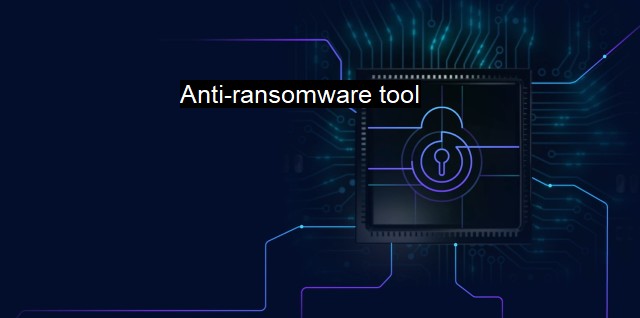What is Anti-ransomware tool?
Defending Against Ransomware: An Introduction to Blockchain-Powered Anti-Ransomware Tools
Anti-ransomware tool is a software or framework designed to shield computer systems from ransomware attacks. While it falls within the antivirus category, it doesn't focus on preventing all forms of malware infections; its main aim is to prevent, detect, and rectify ransomware threats.Understanding ransomware makes it easier to grasp the crucial role of anti-ransomware tools. Ransomware is a harmful software that hackers deploy, depriving a computer user of any access to their files or the system. It encrypts the data in the computer and avails a screen display prompt stating that a ransom must be paid, typically via cryptocurrency, in exchange for a decryption key.
Ransomware essentially holds data or devices hostage until the expected ransom, hence the term ransomware. These cleverly crafted malicious attacks may come via phishing emails or infected removable physical storage devices. Organizations of all sizes, including government agencies, small businesses, hospitals, and financial institutions, are significantly at risk due to the volume and value of the data they handle.
In light of this ever-growing cybersecurity threat, anti-ransomware tools, also known as ransomware protection programs, have gained considerable attention. These tools serve as gatekeepers for your system, defending it from probable ransomware attacks. They use specific detection methods to prevent any surreptitious entry by ransomware strains into a network, ultimately guarding valuable files from encryption. By understanding the persistent evolution of ransomware, developers of these tools are now equipped with the ability to monitor emerging changes.
An anti-ransomware tool often employs some conventional antivirus methodologies. For instance, they can scan and index the secure statuses of files in your device to detect any unauthorized changes promptly. Similarly, some tools use an infrared technique to detect any disk writing trial. A primary key feature is the quarantine operation which segregates or immobilizes suspicious files.
These tools are often distinguished by their use of behavioural detection approaches as opposed to regular antivirus programs, which turn to signature-based detection. Interview-like measures are established when the potential ransomware triggers a suspicion call, thereby appropriately reacting to its conduct. For instance, if the tool notices multiple encryption requests simultaneous, it flags them as possibly unlawful and instantly restrains the menacing application activities.
One fundamental strength of anti-ransomware tools is their ability to restore the encrypted data back to safety without the need for decryption keys. These tools act somewhat like an internal backup remedy, being able to recover your data in the event of a successful ransomware attack. This is advantageous as it eliminates the need to negotiate with cybercriminals or lose valuable data.
In the umbrella of cybersecurity, ransomware is a predominant threat with an extensive potential reach. It's not something that any computer system user can afford to disregard. Dealing with ransomware attacks internally can allocate a significant amount of resources and efforts from an organization. Therefore, any system user needs reliable and hearty ransomware protection fueled by a competent anti-ransomware tool.
Going beyond personal computers, the utilization of anti-ransomware tools is also pertinent in a macro dynamic, hinged to upkeep societal security. Ransomware does not only pose a threat to individual entities; it also threatens the functioning and service delivery of crucial societal sectors like healthcare and the financial industry. Such threats insinuate that everyone bears the brunt of failed cybersecurity protection, driving home why updating and fortifying anti-ransomware tools is an ever-pressing charge.
An anti-ransomware tool is an integral part of any effective cybersecurity and antivirus strategy. It's not only about protecting an individual device but is about safeguarding the wider digital environment while ensuring smooth and uninterrupted service delivery for all users. Adopting an anti-ransomware perspective underscores the value of data while showcasing the urgency and sophistication of modern cybersecurity responses.

Anti-ransomware tool FAQs
What is an anti-ransomware tool?
An anti-ransomware tool is a cybersecurity software that protects your computer against ransomware attacks. It detects and prevents ransomware from encrypting your files and demanding payment to release them.How does an anti-ransomware tool work?
An anti-ransomware tool works by monitoring your computer for suspicious behavior and blocking any malicious activity. It uses advanced algorithms to detect ransomware and stop it before it can encrypt your files. It also creates backups of your data to restore them in case of an attack.Do I need an anti-ransomware tool if I already have antivirus software?
Yes, you should have an anti-ransomware tool even if you have antivirus software. Antivirus software is designed to detect and remove various types of malware, but ransomware is a specific type of threat that requires specialized protection. An anti-ransomware tool complements your antivirus software and provides an additional layer of protection against ransomware attacks.Can an anti-ransomware tool guarantee 100% protection against ransomware attacks?
No cybersecurity software can guarantee 100% protection against all types of threats, including ransomware attacks. However, an anti-ransomware tool can significantly reduce the risk of a successful ransomware attack by detecting and preventing malicious activity. It is also important to keep your software and operating system up to date and regularly back up your data to minimize the impact of a ransomware attack.| | A | | | B | | | C | | | D | | | E | | | F | | | G | | | H | | | I | | | J | | | K | | | L | | | M | |
| | N | | | O | | | P | | | Q | | | R | | | S | | | T | | | U | | | V | | | W | | | X | | | Y | | | Z | |
| | 1 | | | 2 | | | 3 | | | 4 | | | 7 | | | 8 | | |||||||